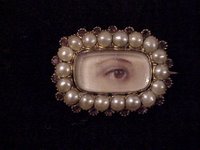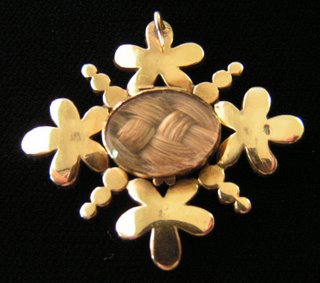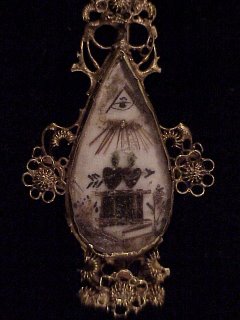Eye Miniatures (updated)
 “When full dressed she wore around her neck the barrenest of lockets, representing a fishy old eye, with no approach to speculation in it” – Charles Dickens, 1848
“When full dressed she wore around her neck the barrenest of lockets, representing a fishy old eye, with no approach to speculation in it” – Charles Dickens, 1848Eye miniatures are perhaps the most intriguing yet misunderstood form of portraiture. It is commonly believed that Richard Cosway began the art of painting eyes in 1785, when he painted those of the Prince of Wales, later George IV, as a gift for the widowed Mrs. Maria Fitzherbert. Sometimes this is punctuated by adding that George Engleheart followed suit and painted his first eye, that of Mrs. Mitchell, in 1796. Both assumptions are incorrect. Engleheart’s extant fee book reveals that his first eye, that of Mrs. Quarrington, was painted in 1783. Cosway’s fee books do not survive to the present day. However, his “Memorandum” of 1795 and the more complete “List of Outstanding Debts: 1776-1820,” which includes the same items listed in the “Memorandum,” provide the only surviving documentation of many of his works including eye and mouth miniatures:
1785 His Eye [The Prince of Wales] £5. 5s.
1786 Mrs. F’s Eye [Mrs. Fitzherbert] £5. 5s.
1795 His Mouth [The Prince of Wales] £5. 5s.
1795 His Eye [The Prince of Wales] £5. 5s.
Mouths never became as popular as eyes and are today exceptionally rare.
The earliest eye miniature by Engleheart predates, by two years, the earliest documented eye miniature by Cosway. Additionally, Williamson cited Ozias Humphrey’s personal papers, which record his having painted two eyes while at Knowle. Humphrey stayed at Knowle Park, the home of the Duke of Dorset, in 1773, thus his eye miniatures predate Cosway’s by twelve years. This is not to assert that Ozias Humphrey began the fashion of painting eyes but that eye miniatures probably began some time before the early 1770s and the exact date and origin are unknown. Eye miniatures were contemporaneously produced in France, and upon seeing “An eye, done at Paris and set in and a delightful Idea, which I admire more than I confess for its singular Beauty and ring,” Lady Eleanor Butler remarked in her diary for 6 December 1785, “A true French idea, Originality”. Though Lady Butler was unaware of English artists producing eye miniatures, her comments suggest the possibility of an early French origin for the art form. From wherever eye miniatures originate, they are likely much older than thus far document. I have seen one eye miniature under heavy faceted crystal, sometimes called “Stuart crystal,” depicting a portion of the right side of the face and single eye of a woman and a portion of her dress, a long narrow brocade bodice. The “Stuart crystal” and cut and fabric of the bodice suggest a date of about 1720. The long history of the eye as a popular symbol allows for entertaining the possibility of an even older origin. Some of the most common symbols in sentimental imagery, a heart pierced with a cupid’s arrow, a forget-me-not, and an eye shedding tears are found on an embroidered ribbon from the earliest 1600s. Similarly, a single winged eye was employed as a personal symbol of the architect and artist Leon Battista Alberti as early as c. 1438.
Eye miniature painted in watercolor on ivory wreathed with garnet and turquoise pansies, pearls, and hair on the reverse. The social role of this eye miniature in sentimental reverie may be seen in the contemplative symbolism of the stones and flowers. From the French word pensée, the pansy is a pun meaning “think of me.” The turquoise, owing to its color, was symbolic of the flower, “forget-me-not,” and the pearls symbolized tears. This miniature was featured in Warman's Jewelry: Third Edition by Christie Romero.

Reverse of the above eye miniature showing the hairwork.

Eye miniature painted in watercolor on ivory and surrounded by pearls and garnets.

There are in fact some links between eye miniatures and the eye of God as a popular devotional symbol. The allegory of love in the pendent below features a hairwork altar with two hearts aflame pierced by Cupid’s arrow beneath the eye of Providence on ivory and surrounded by beautiful cannetille work.

WARNING: Because eye miniatures are so expensive, the market has been recently flooded with fakes. Eyes painted on paper are the easiest to fake, so my general rule is to keep with eyes painted on ivory. However, this is no guarantee of authenticity. Sadly, portrait miniatures are sometimes cut into for the eyes, which, in turn, are reframed in period jewelry. These should be reasonably obvious to experienced collectors. My advice is 1) do not buy any eye miniatures about which you have any doubts or 2) only buy from dealers you trust.



0 Comments:
Post a Comment
<< Home